Page 1000 of 3383
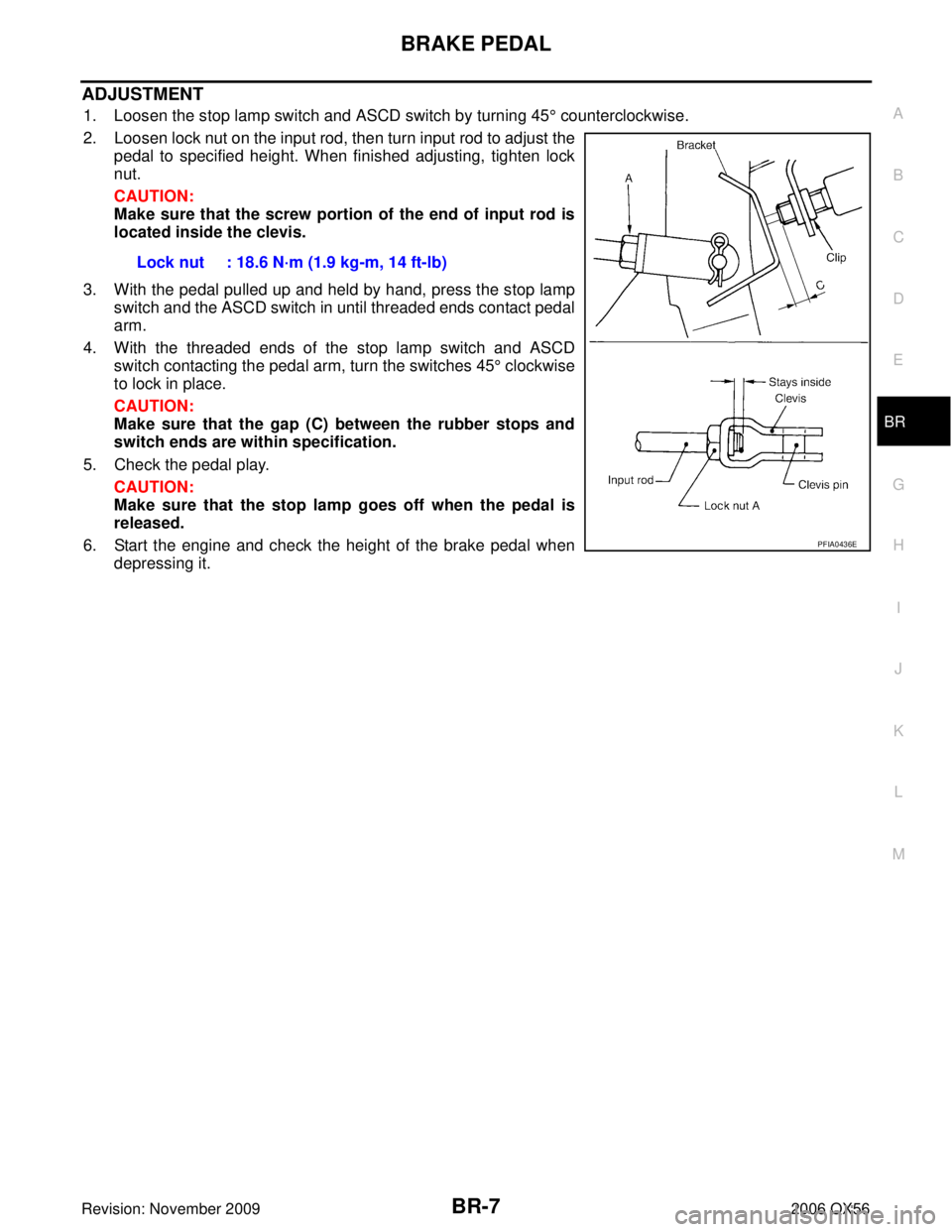
BRAKE PEDALBR-7
C
DE
G H
I
J
K L
M A
B
BR
Revision: November 2009 2006 QX56
ADJUSTMENT
1. Loosen the stop lamp switch and ASCD switch by turning 45° counterclockwise.
2. Loosen lock nut on the input rod, then turn input rod to adjust the pedal to specified height. When finished adjusting, tighten lock
nut.
CAUTION:
Make sure that the screw portion of the end of input rod is
located inside the clevis.
3. With the pedal pulled up and held by hand, press the stop lamp switch and the ASCD switch in until threaded ends contact pedal
arm.
4. With the threaded ends of the stop lamp switch and ASCD switch contacting the pedal arm, turn the switches 45 ° clockwise
to lock in place.
CAUTION:
Make sure that the gap (C) between the rubber stops and
switch ends are within specification.
5. Check the pedal play. CAUTION:
Make sure that the stop lamp goes off when the pedal is
released.
6. Start the engine and check the height of the brake pedal when depressing it.Lock nut : 18.6 N·m (1.9 kg-m, 14 ft-lb)
PFIA0436E
Page 1002 of 3383
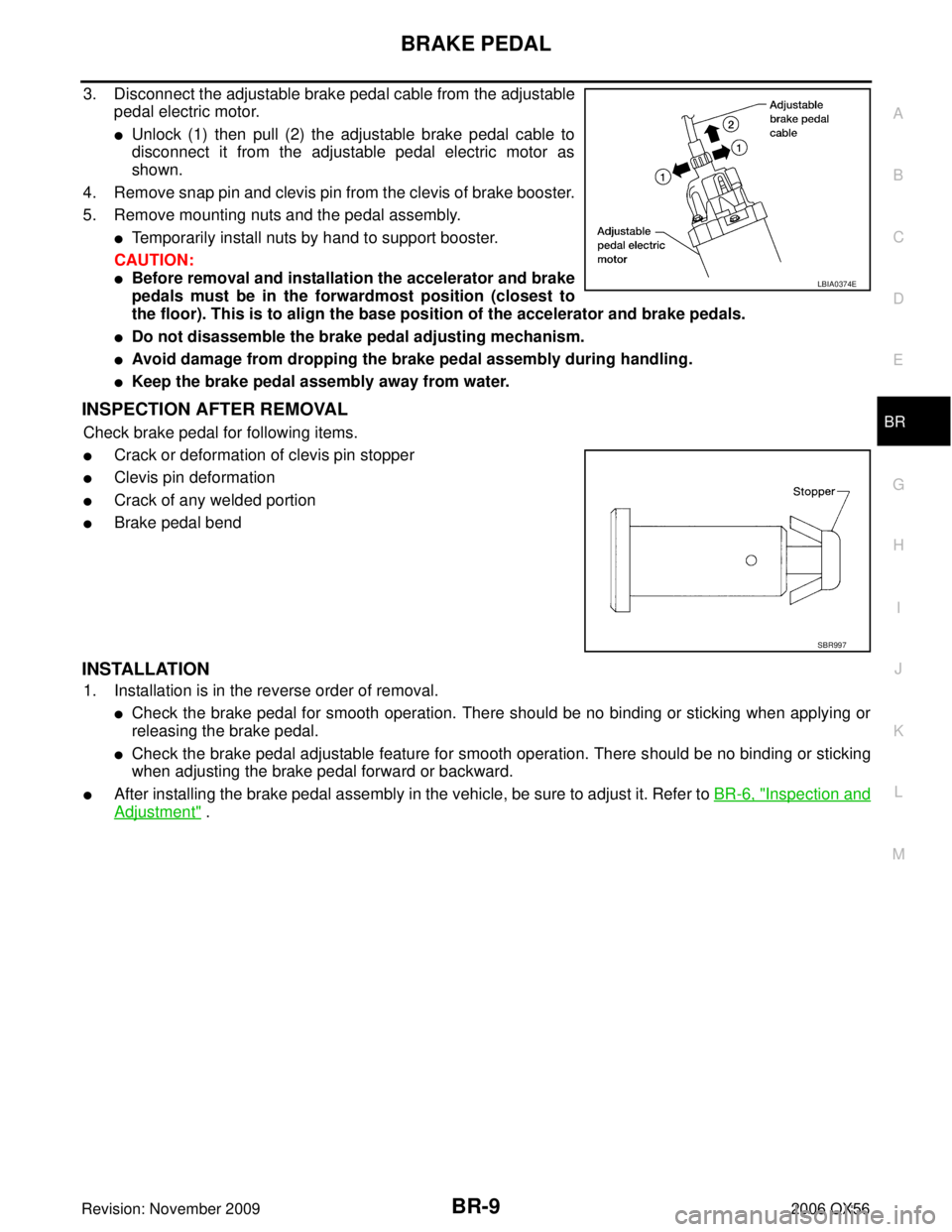
BRAKE PEDALBR-9
C
DE
G H
I
J
K L
M A
B
BR
Revision: November 2009 2006 QX56
3. Disconnect the adjustable brake pedal cable from the adjustable
pedal electric motor.
�Unlock (1) then pull (2) the adjustable brake pedal cable to
disconnect it from the adjustable pedal electric motor as
shown.
4. Remove snap pin and clevis pin from the clevis of brake booster.
5. Remove mounting nuts and the pedal assembly.
�Temporarily install nuts by hand to support booster.
CAUTION:
�Before removal and installation the accelerator and brake
pedals must be in the forwardmost position (closest to
the floor). This is to align the base position of the accelerator and brake pedals.
�Do not disassemble the brake pedal adjusting mechanism.
�Avoid damage from dropping the brake pedal assembly during handling.
�Keep the brake pedal assembly away from water.
INSPECTION AFTER REMOVAL
Check brake pedal for following items.
�Crack or deformation of clevis pin stopper
�Clevis pin deformation
�Crack of any welded portion
�Brake pedal bend
INSTALLATION
1. Installation is in the reverse order of removal.
�Check the brake pedal for smooth operation. There should be no binding or sticking when applying or
releasing the brake pedal.
�Check the brake pedal adjustable feature for smooth operation. There should be no binding or sticking
when adjusting the brake pedal forward or backward.
�After installing the brake pedal assembly in the vehicle, be sure to adjust it. Refer to BR-6, "Inspection and
Adjustment" .
LBIA0374E
SBR997
Page 1005 of 3383
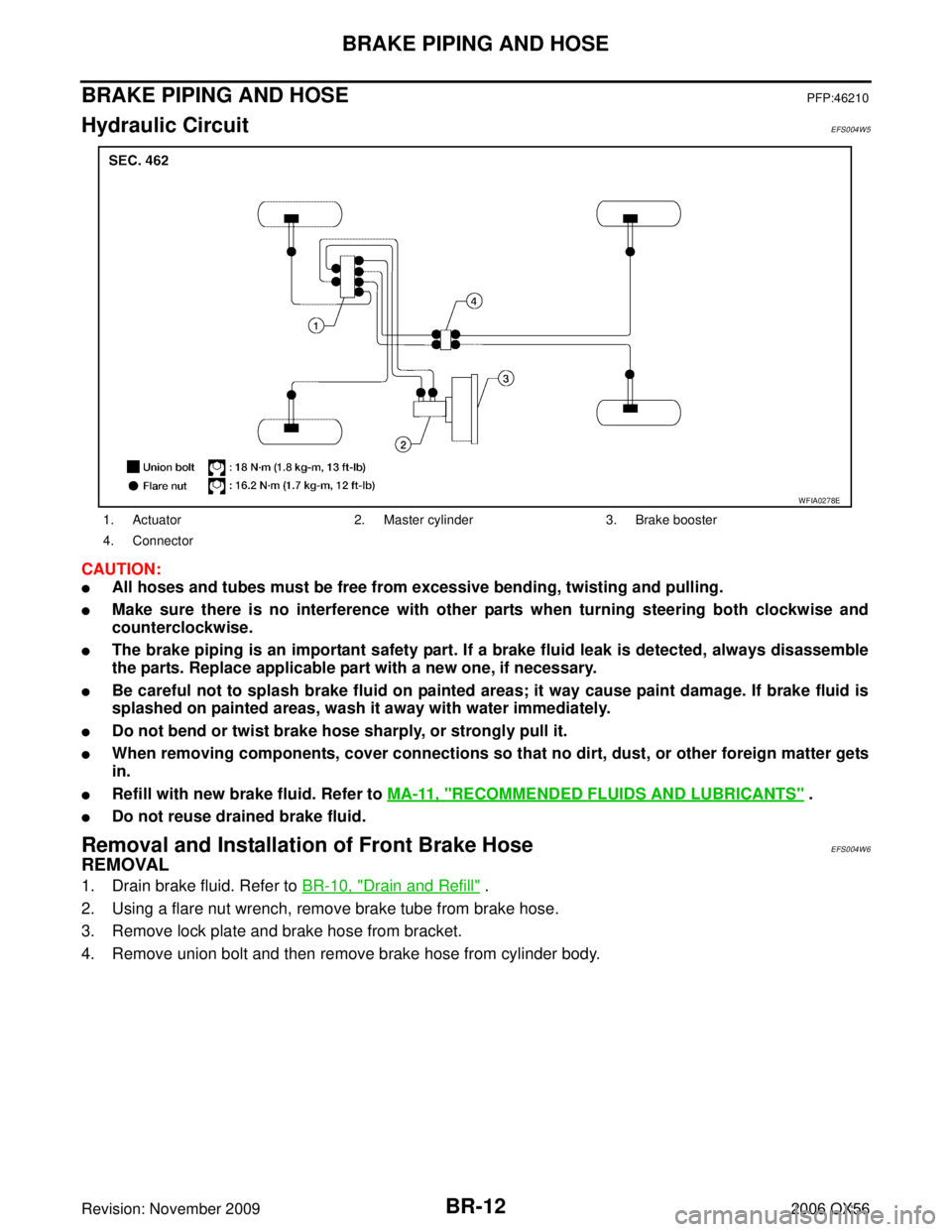
BR-12
BRAKE PIPING AND HOSE
Revision: November 20092006 QX56
BRAKE PIPING AND HOSEPFP:46210
Hydraulic CircuitEFS004W5
CAUTION:
�All hoses and tubes must be free from excessive bending, twisting and pulling.
�Make sure there is no interference with other parts when turning steering both clockwise and
counterclockwise.
�The brake piping is an important safety part. If a brake fluid leak is detected, always disassemble
the parts. Replace applicable part with a new one, if necessary.
�Be careful not to splash brake fluid on painted areas; it way cause paint damage. If brake fluid is
splashed on painted areas, wash it away with water immediately.
�Do not bend or twist brake hose sharply, or strongly pull it.
�When removing components, cover connections so that no dirt, dust, or other foreign matter gets
in.
�Refill with new brake fluid. Refer to MA-11, "RECOMMENDED FLUIDS AND LUBRICANTS" .
�Do not reuse drained brake fluid.
Removal and Installation of Front Brake Hose EFS004W6
REMOVAL
1. Drain brake fluid. Refer to BR-10, "Drain and Refill" .
2. Using a flare nut wrench, remove brake tube from brake hose.
3. Remove lock plate and brake hose from bracket.
4. Remove union bolt and then remove brake hose from cylinder body.
1. Actuator 2. Master cylinder 3. Brake booster
4. Connector
WFIA0278E
Page 1006 of 3383
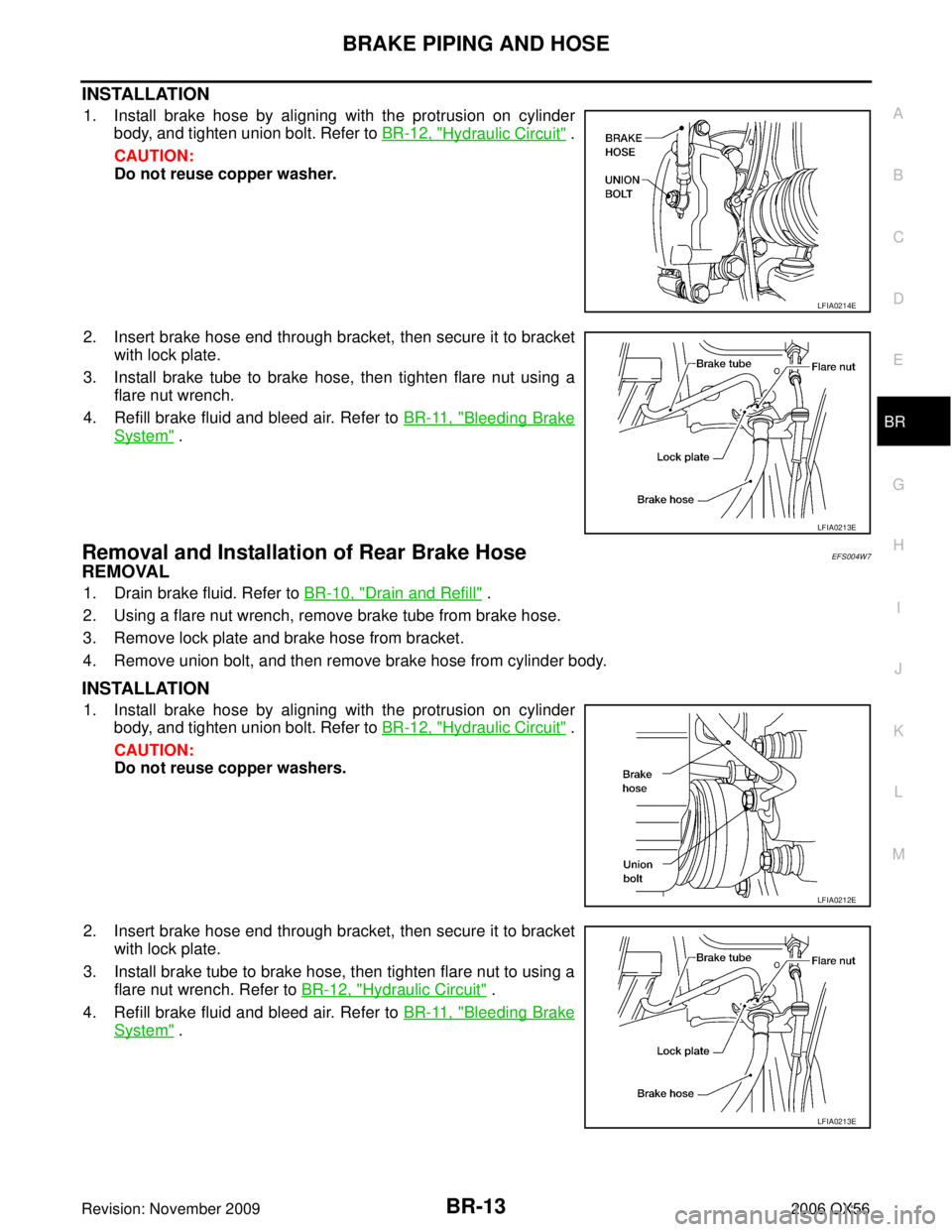
BRAKE PIPING AND HOSEBR-13
C
DE
G H
I
J
K L
M A
B
BR
Revision: November 2009 2006 QX56
INSTALLATION
1. Install brake hose by aligning with the protrusion on cylinder
body, and tighten union bolt. Refer to BR-12, "
Hydraulic Circuit" .
CAUTION:
Do not reuse copper washer.
2. Insert brake hose end through bracket, then secure it to bracket with lock plate.
3. Install brake tube to brake hose, then tighten flare nut using a flare nut wrench.
4. Refill brake fluid and bleed air. Refer to BR-11, "
Bleeding Brake
System" .
Removal and Installation of Rear Brake Hose EFS004W7
REMOVAL
1. Drain brake fluid. Refer to BR-10, "Drain and Refill" .
2. Using a flare nut wrench, remove brake tube from brake hose.
3. Remove lock plate and brake hose from bracket.
4. Remove union bolt, and then remove brake hose from cylinder body.
INSTALLATION
1. Install brake hose by aligning with the protrusion on cylinder body, and tighten union bolt. Refer to BR-12, "
Hydraulic Circuit" .
CAUTION:
Do not reuse copper washers.
2. Insert brake hose end through bracket, then secure it to bracket with lock plate.
3. Install brake tube to brake hose, then tighten flare nut to using a flare nut wrench. Refer to BR-12, "
Hydraulic Circuit" .
4. Refill brake fluid and bleed air. Refer to BR-11, "
Bleeding Brake
System" .
LFIA0214E
LFIA0213E
LFIA0212E
LFIA0213E
Page 1011 of 3383
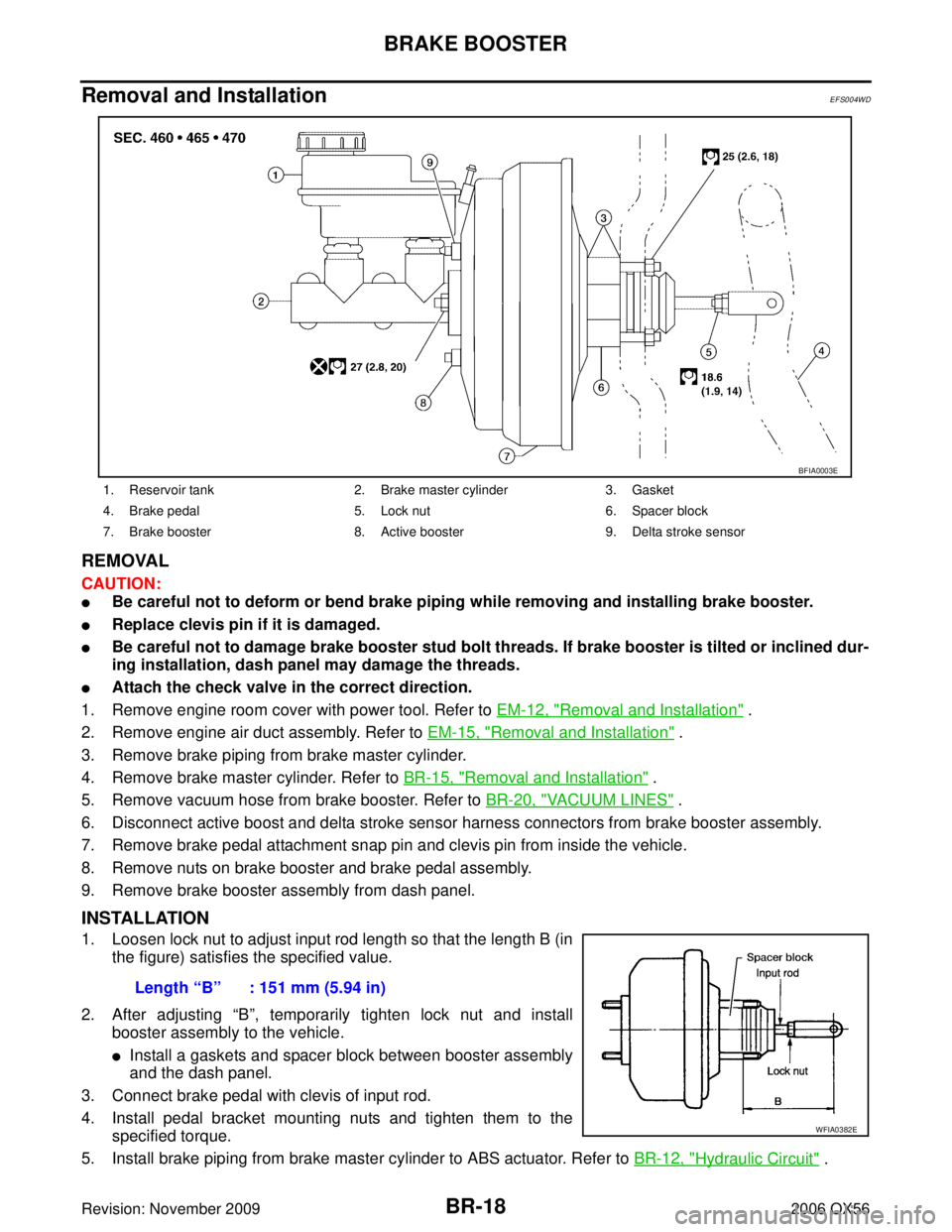
BR-18
BRAKE BOOSTER
Revision: November 20092006 QX56
Removal and InstallationEFS004WD
REMOVAL
CAUTION:
�Be careful not to deform or bend brake piping while removing and installing brake booster.
�Replace clevis pin if it is damaged.
�Be careful not to damage brake booster stud bolt threads. If brake booster is tilted or inclined dur-
ing installation, dash panel may damage the threads.
�Attach the check valve in the correct direction.
1. Remove engine room cover with power tool. Refer to EM-12, "
Removal and Installation" .
2. Remove engine air duct assembly. Refer to EM-15, "
Removal and Installation" .
3. Remove brake piping from brake master cylinder.
4. Remove brake master cylinder. Refer to BR-15, "
Removal and Installation" .
5. Remove vacuum hose from brake booster. Refer to BR-20, "
VACUUM LINES" .
6. Disconnect active boost and delta stroke sensor harness connectors from brake booster assembly.
7. Remove brake pedal attachment snap pin and clevis pin from inside the vehicle.
8. Remove nuts on brake booster and brake pedal assembly.
9. Remove brake booster assembly from dash panel.
INSTALLATION
1. Loosen lock nut to adjust input rod length so that the length B (in the figure) satisfies the specified value.
2. After adjusting “B”, temporarily tighten lock nut and install
booster assembly to the vehicle.
�Install a gaskets and spacer block between booster assembly
and the dash panel.
3. Connect brake pedal with clevis of input rod.
4. Install pedal bracket mounting nuts and tighten them to the specified torque.
5. Install brake piping from brake master cylinder to ABS actuator. Refer to BR-12, "
Hydraulic Circuit" .
1. Reservoir tank 2. Brake master cylinder 3. Gasket
4. Brake pedal 5. Lock nut 6. Spacer block
7. Brake booster 8. Active booster 9. Delta stroke sensor
BFIA0003E
Length “B” : 151 mm (5.94 in)
WFIA0382E
Page 1012 of 3383
BRAKE BOOSTERBR-19
C
DE
G H
I
J
K L
M A
B
BR
Revision: November 2009 2006 QX56
6. Connect active boost and delta stroke sensor harness connectors to brake booster assembly.
7. Connect vacuum hose to brake booster.
8. Install master cylinder to booster assembly. Refer to BR-18, "
Removal and Installation" .
9. Adjust the height and play of brake pedal.
10. Tighten lock nut of input rod to specification.
11. Install engine air duct assembly. Refer to EM-15, "
Removal and Installation" .
12. Install engine room cover with power tool. Refer to EM-12, "
Removal and Installation" .
13. Refill with new brake fluid and bleed air. Refer to BR-11, "
Bleeding Brake System" .
Page 1016 of 3383
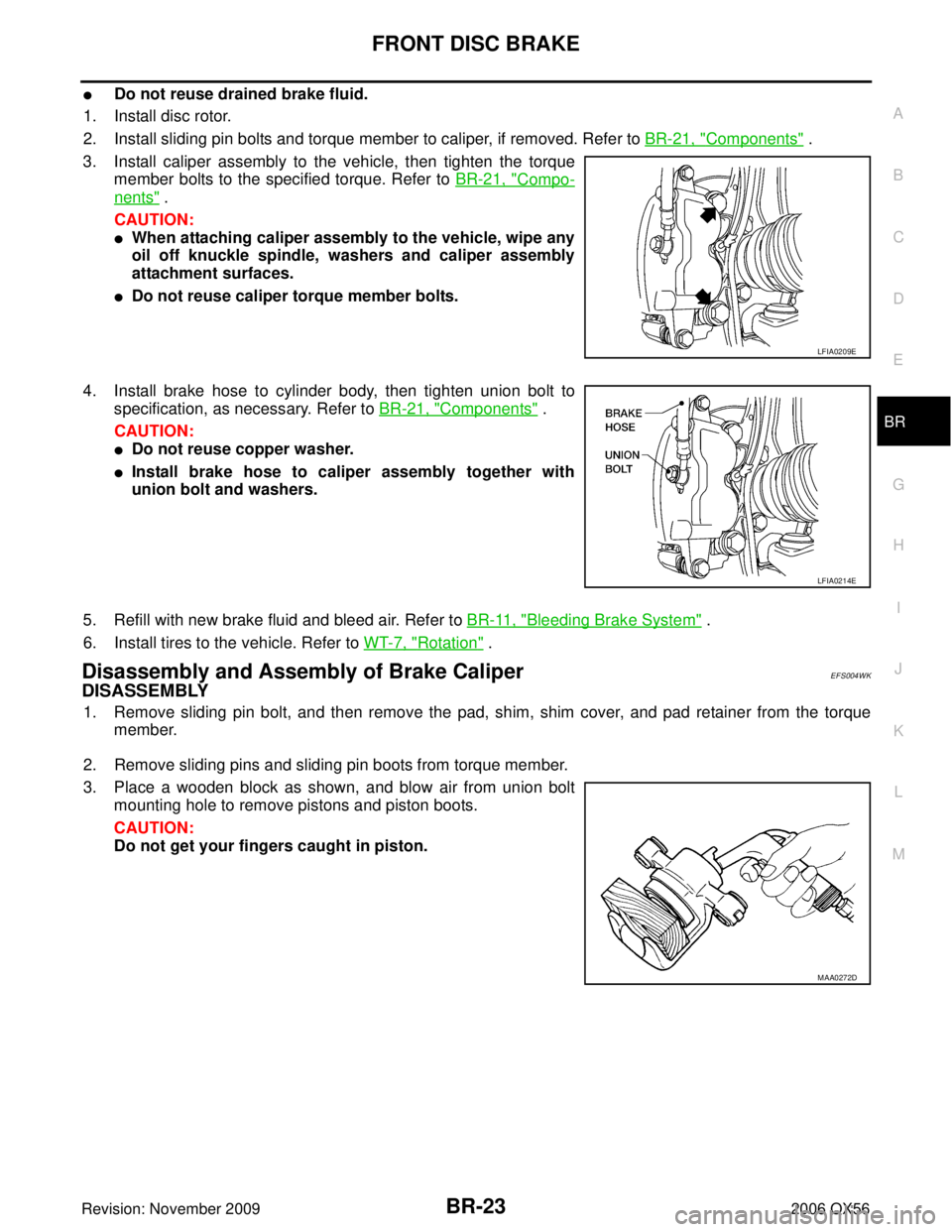
FRONT DISC BRAKEBR-23
C
DE
G H
I
J
K L
M A
B
BR
Revision: November 2009 2006 QX56
�Do not reuse drained brake fluid.
1. Install disc rotor.
2. Install sliding pin bolts and torque member to caliper, if removed. Refer to BR-21, "
Components" .
3. Install caliper assembly to the vehicle, then tighten the torque member bolts to the specified torque. Refer to BR-21, "
Compo-
nents" .
CAUTION:
�When attaching caliper assembly to the vehicle, wipe any
oil off knuckle spindle, washers and caliper assembly
attachment surfaces.
�Do not reuse caliper torque member bolts.
4. Install brake hose to cylinder body, then tighten union bolt to specification, as necessary. Refer to BR-21, "
Components" .
CAUTION:
�Do not reuse copper washer.
�Install brake hose to caliper assembly together with
union bolt and washers.
5. Refill with new brake fluid and bleed air. Refer to BR-11, "
Bleeding Brake System" .
6. Install tires to the vehicle. Refer to WT-7, "
Rotation" .
Disassembly and Assembly of Brake CaliperEFS004WK
DISASSEMBLY
1. Remove sliding pin bolt, and then remove the pad, shim, shim cover, and pad retainer from the torque member.
2. Remove sliding pins and sliding pin boots from torque member.
3. Place a wooden block as shown, and blow air from union bolt mounting hole to remove pistons and piston boots.
CAUTION:
Do not get your fingers caught in piston.
LFIA0209E
LFIA0214E
MAA0272D
Page 1022 of 3383
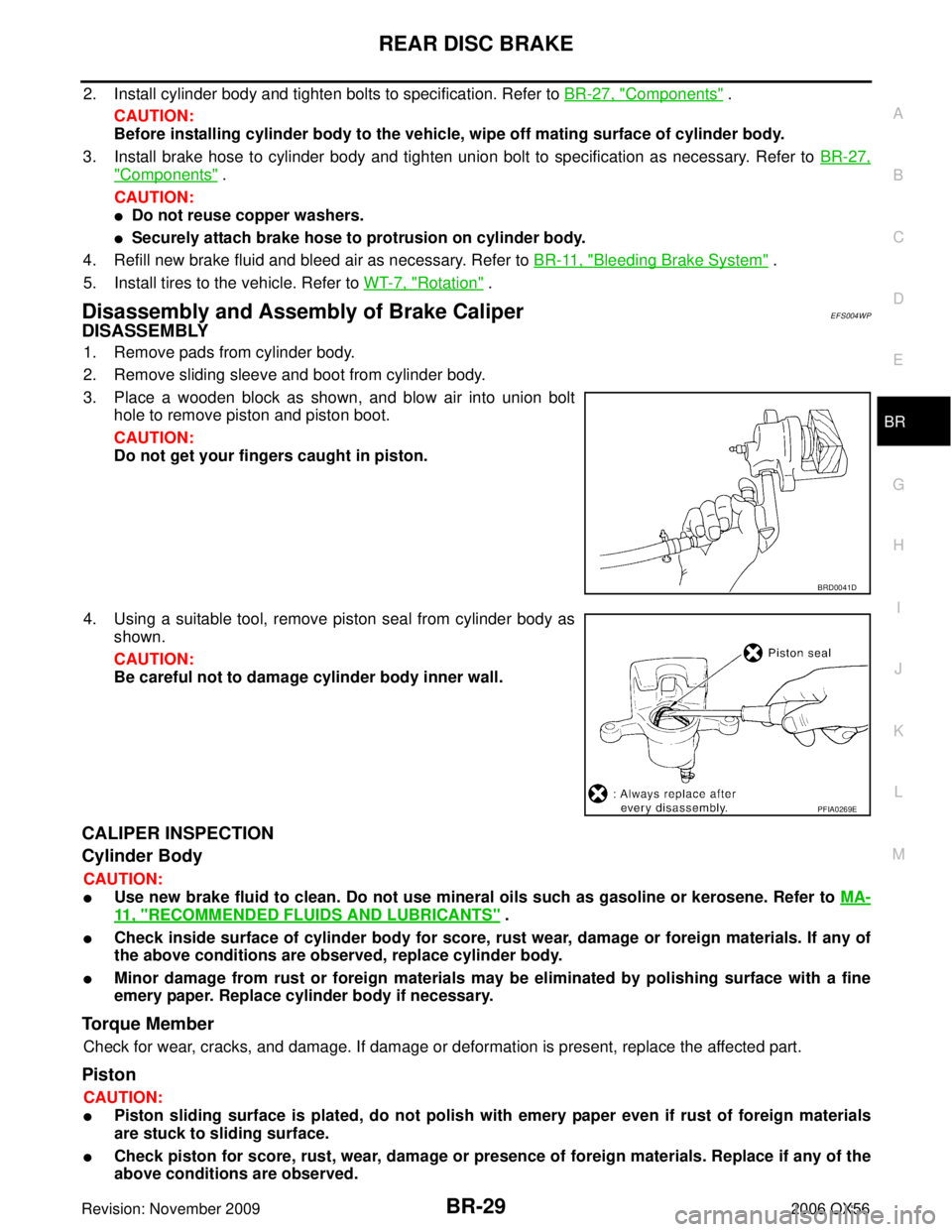
REAR DISC BRAKEBR-29
C
DE
G H
I
J
K L
M A
B
BR
Revision: November 2009 2006 QX56
2. Install cylinder body and tighten bolts to specification. Refer to BR-27, "Components" .
CAUTION:
Before installing cylinder body to the vehicle, wipe off mating surface of cylinder body.
3. Install brake hose to cylinder body and tighten union bolt to specification as necessary. Refer to BR-27,
"Components" .
CAUTION:
�Do not reuse copper washers.
�Securely attach brake hose to protrusion on cylinder body.
4. Refill new brake fluid and bleed air as necessary. Refer to BR-11, "
Bleeding Brake System" .
5. Install tires to the vehicle. Refer to WT-7, "
Rotation" .
Disassembly and Assembly of Brake CaliperEFS004WP
DISASSEMBLY
1. Remove pads from cylinder body.
2. Remove sliding sleeve and boot from cylinder body.
3. Place a wooden block as shown, and blow air into union bolt hole to remove piston and piston boot.
CAUTION:
Do not get your fingers caught in piston.
4. Using a suitable tool, remove piston seal from cylinder body as shown.
CAUTION:
Be careful not to damage cylinder body inner wall.
CALIPER INSPECTION
Cylinder Body
CAUTION:
�Use new brake fluid to clean. Do not use mineral oils such as gasoline or kerosene. Refer to MA-
11 , "RECOMMENDED FLUIDS AND LUBRICANTS" .
�Check inside surface of cylinder body for score, rust wear, damage or foreign materials. If any of
the above conditions are observed, replace cylinder body.
�Minor damage from rust or foreign materials may be eliminated by polishing surface with a fine
emery paper. Replace cylinder body if necessary.
To r q u e M e m b e r
Check for wear, cracks, and damage. If damage or deformation is present, replace the affected part.
Piston
CAUTION:
�Piston sliding surface is plated, do not polish with emery paper even if rust of foreign materials
are stuck to sliding surface.
�Check piston for score, rust, wear, damage or presence of foreign materials. Replace if any of the
above conditions are observed.
BRD0041D
PFIA0269E